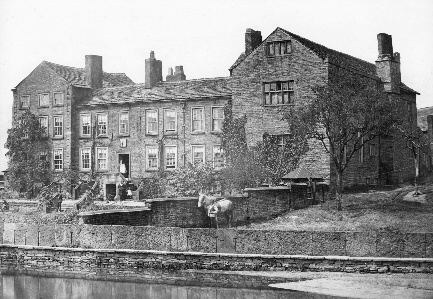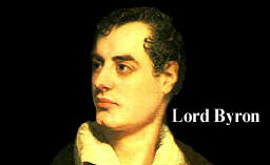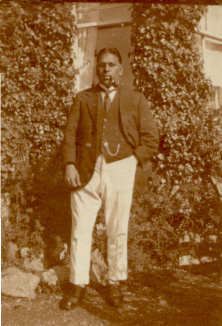Royton Hall
 THE HISTORY
THE HISTORYRoyton Hall was an ancient edifice of uncertain date. It was set in its own grounds and constructed of Saddleworth stone and oak from the Chadderton Forest. The park, belonging to the Hall was thickly wooded with sycamore, beech, chestnut, oak, poplars and other forest trees. Deer and other game abounded in profusion. The gardens, which were extensive and well cultivated, extended to the park wall at Edge Lane. In the 18th and 19th centuries they were kennels for a pack of harriers. Royton Spinning Mill was later built on this site.
Relatively little is known about the date of Royton Hall's construction, but it is thought to date back as far as the 13th century, when the Byron family leased the property. The discovery of wattle and daub walls during the Hall's demolition in 1939 suggested its medieval origins. The east wing was thought to have been built during Elizabethan times (1558-1603). More recent evidence however suggests that the wing was Jacobean (1603-25) in origin. By 1666, the Hall was recorded as having 12 hearths, while the rest of the village only had 42 hearths in 30 households, which shows how palatial the Hall was in comparison to the houses in the village.
Thomas and Martha Percival constructed the Georgian section of the Hall (centre and west wing) over an older basement in 1758. Later, part of the house had to be rebuilt after an accident on 10th April, 1790. On that morning a tremendous gust of wind blew down two 18ft "chimnies" in front of the house.
In 1795, the Hall was described as "a firm, well-built stone edifice of ancient date, remarkable for an uncommonly strong and heavy round staircase, like that of a church, but more massy". A small stream ran in front of the Hall, which divided the garden from rich meadow. A summer-house was built "in the adjoining walled park, built upon a hill called the Sun Low, whence is a very extensive prospect of the circumjacent country, as far as the Welch mountains".
 The Hall became available for lease in November 1795 after Sir Joseph Radcliffe moved to Milns Bridge. The advertisement read:
The Hall became available for lease in November 1795 after Sir Joseph Radcliffe moved to Milns Bridge. The advertisement read:"To be Let, All that Capital Mansion House called Royton Hall, situate at Royton, consisting of one Hall, a Dining Room, a Drawing Room, a Study, two Parlours, Housekeeper's and Store Room, Kitchen, Scullery, Servant's Hall, Butler's Pantry and Larder, on the first floor, seven of which Rooms are Cellared under: second Storey, seven best Bed Chambers, seven Chambers for Servants, a Laundry, and good Garrets; together with a good Barn, Corn Chamber, and two Coach Houses, Stables for 17 horses, Cow House for 8 cows, with Hay lofts over them, a Cart House and Brew House, and open Stable for a Sick and Lamed horse; a Paddock adjoining the Stables, with a good brick wall round it 7ft. high, containing 38A (acres) 3R (roods) 31P (poles), four rich Meadows at the Front of the House, 13A 3R 0P, a large Garden well stocked with Fruit Trees, a Vinery covered with Glass 90 feet long, the Trees in full bearing order, an Orchard and Dog Kennel".
In the early 19th century the fortunes of Royton Hall were on the wane and by 1832 the Hall was "neglected and decayed" and all its grounds "dreary and forlorn". The summerhouse had been demolished just prior to 1817 and the park divided into farms. The new road to Rochdale was soon to cut through these "once retired and beautiful demesnes".
Several interesting features are known about the Hall. At the end of the 19th century there was an old, peculiarly shaped sundial, the dial of which consisted of 13 sides and was situated in front of the house. There was another sundial above the main entrance door.
 In the early 20th century there was talk of the Hall being preserved as public property. In 1926 the then owner Dr Godfrey tried to sell the Hall to Manchester and Oldham Councils, and the National Trust. The Ancient Monuments Society suggested that Royton Council purchase the property, but the offer was declined as the Council "were unable to see to what useful purpose the Hall could be put". The cost of restoration and maintenance would also have been too high. The Hall remained unsold and was converted into apartments. From about 1937, it was unoccupied and during that time it became a favourite playground for children, one of whom remembers a fireplace, in a room above and to the left of the front entrance, surrounded by tiles depicting scenes from Aesop's Fables. In 1938, Royton Council, on the advice of the Medical Officer of Health, placed the house under a slum clearance order and the Hall was demolished in February, 1939. The salvageable building materials were auctioned off, several items going to America. Today, the site, situated behind the shops on Middleton Road and to the east of Hall Street, remains as a public open space.
In the early 20th century there was talk of the Hall being preserved as public property. In 1926 the then owner Dr Godfrey tried to sell the Hall to Manchester and Oldham Councils, and the National Trust. The Ancient Monuments Society suggested that Royton Council purchase the property, but the offer was declined as the Council "were unable to see to what useful purpose the Hall could be put". The cost of restoration and maintenance would also have been too high. The Hall remained unsold and was converted into apartments. From about 1937, it was unoccupied and during that time it became a favourite playground for children, one of whom remembers a fireplace, in a room above and to the left of the front entrance, surrounded by tiles depicting scenes from Aesop's Fables. In 1938, Royton Council, on the advice of the Medical Officer of Health, placed the house under a slum clearance order and the Hall was demolished in February, 1939. The salvageable building materials were auctioned off, several items going to America. Today, the site, situated behind the shops on Middleton Road and to the east of Hall Street, remains as a public open space.Several reminders of the Hall and its owners remain: the name "Hall Street", a single gatepost (originally from the 19th century rear entrance gatepost on Middleton road which was moved from its original position to Hall Street in 1989 in order to make way for new shops) and several street names; Byron Street, Percival Walk, Pickford Walk and Radcliffe Street.
Extracts reproduced by kind permission of Frances Stott from "A History of Royton Hall" (Greenfield House Publications - £3.99), the proceeds of which are donated to Dr.Kershaw's Hospice.
OWNERS & OCCUPIERS
For over four centuries, Royton Hall was home to 12 generations of the Byron family. Their most famous descendant, in the 19th century, was the poet George Gordon, the 6th Lord Byron. It is not clear when the Byron family first settled in Royton. In 1212, the owner of the Royton estate was the thane, William, son of William, who held 12 oxgangs of land for a payment of 24 shillings a year. The estate was inherited by William's son, Thomas, and then by Thomas's daughter, Marjory, and her husband Alexander Lutteral. Some time prior to 1246, the Lutteral family leased the land to Alice de Byrun. She in turn sublet "the whole town of Rybeton" to Roger Gernet "to farm". In 1246, Alice's son Roger de Byrun came of age and Roger Gernet restored the estate to him. Roger de Byrun died in 1259 and the lease of the estate passed to his next of kin, Sir John Byron, Lord of Clayton, who, by 1270, had purchased the estate from the Lutterels.
 The Byron family, the majority of whom were confusingly called John, were very much involved in affairs of state and took an active part in the life of the country. Over the centuries they took part in wars in Wales, France, Flanders, Scotland and Spain as well as at home, siding with the King against Parliament. They were members of the English Church, both before and after the Reformation. During the reign of Elizabeth I, the Hall was inherited by the illegitimate son of Sir John Byron, who had purchased Newstead Abbey in 1540. This son, also called John, became High Sheriff of Lancashire in 1572 and in 1585 was reputed to have made Royton Hall his home. He wrote several letters from Royton in 1585 regarding the raising of troops against the Armada. He died in 1603. The Byron family sold Royton Hall in 1622 to the Standish family who in turn sold the Hall with all their cottages and tenements and all their interest in Chaterton (Chadderton) and Royton, on 20th March, 1662, to Richard Percival of Liverpool and Thomas Percival of Crumsall, a wealthy linen manufacturer for £2,530.
The Byron family, the majority of whom were confusingly called John, were very much involved in affairs of state and took an active part in the life of the country. Over the centuries they took part in wars in Wales, France, Flanders, Scotland and Spain as well as at home, siding with the King against Parliament. They were members of the English Church, both before and after the Reformation. During the reign of Elizabeth I, the Hall was inherited by the illegitimate son of Sir John Byron, who had purchased Newstead Abbey in 1540. This son, also called John, became High Sheriff of Lancashire in 1572 and in 1585 was reputed to have made Royton Hall his home. He wrote several letters from Royton in 1585 regarding the raising of troops against the Armada. He died in 1603. The Byron family sold Royton Hall in 1622 to the Standish family who in turn sold the Hall with all their cottages and tenements and all their interest in Chaterton (Chadderton) and Royton, on 20th March, 1662, to Richard Percival of Liverpool and Thomas Percival of Crumsall, a wealthy linen manufacturer for £2,530.The Percival family and their descendants lived at the Hall during the 17th and 18th centuries. Thomas Percival, great grandson of the original owner was a magistrate, who examined local Jacobites when a rebel patrol entered Royton and Oldham in November 1745. In 1753, he gave the land for the building of Royton Chapel, together with £100 towards its construction. Thomas Percival married Martha, daughter of Major Benjamin Gregge of Chamber, Oldham, on 14th March, 1738. She died on 17th March, 1760, aged 45, and was buried in the vault of Royton Chapel. Thomas died in 1762 and was buried in the same vault.
Thomas and Martha Percival had one child, Katherine, born 15th March, 1740, who married Joseph Pickford of Althill on 3rd March, 1763, at Oldham Church. Katherine died on 15th May, 1765, leaving a son, William Percival Pickford, who was born on 18th December, 1763. He inherited Royton Hall, but died childless in 1815, bequeathing his estates to his father, Joseph Pickford, who had since remarried twice and fathered several more children.
Joseph Pickford was the nephew of William Radcliffe, of Milns Bridge, Yorkshire and inherited his estates on his maternal uncle's death on 26th September, 1795. In compliance with his uncle's will, Joseph took the name of Radcliffe of Langley and was created a baronet on 2nd November, 1813, "for his exemplary exertions as a magistrate in quelling a system of insubordination, which existed amongst the operative cloth dressers of Yorkshire" who were destroying machinery under the impression that their use was damaging trade and hence the livelihoods. Sir Joseph died on 19th February 1819, at Clifton, Bristol, and although he had ceased to reside at Royton Hall some time prior to his death, he was buried at Royton Church. The estate then passed to his grandson, Sir Joseph Radcliffe, who died in 1872, who was the last Radcliffe to be born and educated at Royton Hall, and then to his son, Sir Joseph Percival Pickford Radcliffe.
After Sir Joseph Radcliffe moved to Milns Bridge in 1795, Royton Hall became available for lease. In 1796 the Rev Ethelston resided at the Hall along with Sir Joseph's son-in-law, Joseph Starkey, a Captain in the 16th Regiment, and High Sheriff of Lancashire in 1799. He resided at the Hall until his death in 1804, after which the hall was leased to the Rev. Joseph Hordern, the minister of Shaw Chapel, the Hall served him both as a residence and as a seminary for the tuition of a number of noblemen and gentleman's sons (including the aforementioned Sir Joseph Radcliffe) until 1814-5, when he moved to Failsworth Lodge, near Manchester.
Royton Hall's next tenant, in 1815, was Edmund Wild, a cotton manufacturer who had a mill in Sandy Lane. In 1817, the surgeon William Taylor was also in residence. Wild continued to reside at the Hall until the mid 1830s. In 1833, John Fitton, a farmer, leased part of the Hall. In 1834, the rear portion of the Hall had been divided into numerous tenements.
The 1861 Census lists various families living in the Hall, including John Travis (a farmer of 45 acres), William Ireland (a farrier), George Hall (a house joiner), Hannah Gornal (a cotton reeler), Samuel Cooper (a proprietor of houses, although 10 years previously he had stated his occupation as a roller coverer), William Mills (Wesleyan Day School teacher), William Andrew (a cotton manufacturer), and James Brierley (formerly a cotton carder). Of those living there ten years later, John Beckett was bookkeeper and cotton yarn salesman at the Union Street Mills.
The Radcliffe family were benefactors to the Roman Catholic Church of SS Aiden & Oswald, providing both the land at Dryclough and £2000 towards the cost of construction of the church and school. In 1882, at their agent Gosford's suggestion, the south front was "offered to his Lordship the Bishop as a temporary residence, rent free" for the Priest and "the fine old drawing room which with its two high side windows and fine old mullioned windows to the South" as a private chapel. Several Priests were to reside at the Hall until the Presbytery was built in 1900. These included the Rev. John Willemse in 1891 and later the Rev. D. M'Intosh & Rev. Timothy Cusack.
 In the early 20th century, the Hall was divided into 3 residences. At one time it was also used as a Church Institute for St Paul's Church and as a doctor's surgery.
In the early 20th century, the Hall was divided into 3 residences. At one time it was also used as a Church Institute for St Paul's Church and as a doctor's surgery.During the First World War, Sir Joseph Radcliffe lent Royton Hall to house refugees from Belgium. Two families arrived in October 1914, Mr & Mrs Byl and their 5 children from Ghent (who were allocated 2 large living rooms in the Hall and 3 bedrooms) and Mr & Mrs Mayor and their 3 children from Ostend. Both families obtained work locally and moved from the Hall in February 1915, having taken houses in Charles St & John St. Other refugees arrived to take their place at the Hall.
After the war, the Hall was rented by Dr J T Godfrey, who used it for his home and surgery. The Doctor, who was from South Africa, though Asian by birth, finally purchased the Hall and an acre of surrounding land from Sir Joseph Edward Radcliffe in December, 1922, with the exception of "the oak floor and oak mantel piece in the old ballroom, the oak staircase leading up to the bedrooms and the whole of the oak panelling". He purchased these in April, 1926.
Dr.Godfrey and his family moved back to South Africa for 2 years in 1926, after which they returned to live in Southampton. Prior to his departure, he tried but failed to sell the Hall. Dr Godfrey died in November 1935 and the estate passed to his widow. Royton Council eventually purchased the site of the Hall in July 1961 and later landscaped the site.